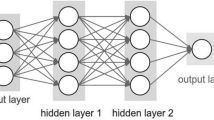Abstract
This paper investigates the modeling of the daily total global solar radiation in Adana city of Turkey using multi-linear regression (MLR), multi-nonlinear regression (MNLR) and feed-forward artificial neural network (ANN) methods. Several daily meteorological data, i.e., measured sunshine duration, air temperature and wind speed and date of the year, i.e., monthly and daily, were used as independent variables to the MLR, MNLR and ANN models. In order to determine the relationship between the total global solar radiation and other meteorological data, and also to obtain the best independent variables, the MLR and MNLR analyses were performed with the “Stepwise” method in the Statistical Packages for the Social Sciences (SPSS) program. Thus, various models consisting of the combination of the independent variables were constructed and the best input structure was investigated. The performances of all models in the training and testing data sets were compared with the measured daily global solar radiation values. The obtained results indicated that the ANN method was better than the other methods in modeling daily total global solar radiation. For the ANN model, mean absolute error (MAE), mean absolute percentage error (MAPE), correlation coefficient (R) and coefficient of determination (R 2) for the training/testing data set were found to be 0.89/1.00 MJ/m2 day, 7.88/9.23%, 0.9824/0.9751, and 0.9651/0.9508, respectively.
















Similar content being viewed by others
Abbreviations
- ANN:
-
Artificial neural network
- b :
-
Bias
- BP:
-
Back-propagation
- D :
-
Day of the month
- FFNN:
-
Feed-forward neural network
- GRNN:
-
Generalized regression neural network
- H :
-
Global solar radiation (MJ/m2 day)
- LM:
-
Levenberg–Marquardt
- LR:
-
Linear regression
- MAE:
-
Mean absolute error (MJ/m2 day)
- MAPE:
-
Mean absolute percentage error (%)
- MLR:
-
Multi-linear regression
- MNLR:
-
Multi-nonlinear regression
- M :
-
Month of the year
- m :
-
Measured value
- n :
-
Total number of data
- p :
-
Predicted value
- R :
-
Correlation coefficient
- R 2 :
-
Coefficient of determination
- RBNN:
-
Radial basis neural network
- S :
-
Sunshine duration (h)
- SPSS:
-
Statistical packages for the social sciences
- t j :
-
Target output of the node j
- T :
-
Atmospheric temperature (°C)
- TSMS:
-
Turkish State Meteorological Service
- x :
-
Net input of the weighted values of the individual inputs (\( p_{1} ,p_{2} , \ldots ,p_{3} \))
- X :
-
Independent variable
- X N :
-
Normalized value
- X min :
-
Minimal value
- X max :
-
Maximal value
- VIF:
-
Variation inflation factor
- w :
-
Weight
- w S :
-
Measurement accuracy of sunshine duration (h)
- w T :
-
Measurement accuracy of air temperature (°C)
- w W :
-
Measurement accuracy of wind speed (m/s)
- w H :
-
Uncertainty amount of solar radiation (±%)
- W :
-
Wind speed (m/s)
- y j :
-
Output of the node j
- Y :
-
Dependent variable
- α :
-
Equation parameter for nonlinear regression; momentum factor
- β :
-
Equation parameter for linear regression
- η :
-
Learning rate
- δ k :
-
Error term of the output layer
References
Abdul-Wahab SA, Bakheit CS, Al-Alawi SM (2005) Principle component and multiple regression analysis in modeling of ground-level ozone and factors affecting its concentrations. Environ Model Softw 20:1263–1271
Bezir NC, Akkurt I, Ozek N (2010a) Estimation of horizontal solar radiation in Isparta (Turkey). Energy Sources 32:512–517
Bezir NC, Akkurt I, Ozek N (2010b) The development of a computer program for estimating solar radiation. Energy Sources 32:995–1003
Bilgili M (2010) Prediction of soil temperature using regression and artificial neural network models. Meteorol Atmos Phys 110:59–70
Bilgili M, Sahin B (2010a) Comparative analysis of regression and artificial neural network models for wind speed prediction. Meteorol Atmos Phys 109:61–72
Bilgili M, Sahin B (2010b) Prediction of long-term monthly temperature and rainfall in Turkey. Energy Sources 32:60–71
Bilgili M, Sahin B, Yasar A (2007) Application of artificial neural networks for the wind speed prediction of target station using reference stations data. Renew Energy 32:2350–2360
Bulut H, Büyükalaca O (2007) Simple model for the generation of daily global solar-radiation data in Turkey. Appl Energy 84:477–491
Cankaya S (2009) A comparative study of some estimation methods for parameters and effects of outliers in simple regression model for research on small ruminants. Trop Anim Health Prod 41:35–41
Cao JC, Cao SH (2006) Study of forecasting solar irradiance using neural networks with preprocessing sample data by wavelet analysis. Energy 31:3435–3445
Cevik A (2007) Unified formulation for web crippling strength of cold-formed steel sheeting using stepwise regression. J Constr Steel Res 63:1305–1316
Chaar LE, Lamont LA (2010) Global solar radiation: multiple on-site assessments in Abu Dhabi, UAE. Renew Energy 35:1596–1601
Elminir HK, Azzam YA, Younes FI (2007) Prediction of hourly and daily diffuse fraction using neural network, as compared to linear regression models. Energy 32:1513–1523
El-Sebaii AA, Al-Hazmi FS, Al-Ghamdi AA, Yaghmour SJ (2010) Global, direct and diffuse solar radiation on horizontal and tilted surfaces in Jeddah, Saudi Arabia. Appl Energy 87:568–576
Firat M, Gungor M (2009) Generalized regression neural networks and feed forward neural networks for prediction of scour depth around bridge piers. Adv Eng Softw 40:731–737
Ghanbarzadeh A, Noghrehabadi AR, Assareh E, Behrang MA (2009) Solar radiation forecasting based on meteorological data using artificial neural networks. In: Proceedings of the 7th IEEE international conference on industrial informatics, pp 227–231
Guhathakurta P (2008) Long lead monsoon rainfall prediction for meteorological sub-divisions of India using deterministic artificial neural network model Meteorol Atmos Phys 101:93–108
Guhathakurta P, Rajeevan M, Thapliyal V (1999) Long range forecasting Indian summer monsoon rainfall by a hybrid principal component neural network model. Meteorol Atmos Phys 71:255–266
Haykin S (1994) Neural networks. A comprehensive foundation. Prentice-Hall, New Jersey
Holman JP (2000) Experimental methods for engineers, 7th edn. McGraw-Hill, New York
Kalogirou SA (2001) Artificial neural networks in renewable energy systems applications: a review. Renew Sustain Energy Rev 5:373–401
Kalogirou SA, Bojic M (2000) Artificial neural networks for the prediction of the energy consumption of a passive solar building. Energy 25:479–491
Kang L, Zhou S, Yu K (2009) Global solar radiation estimation based on sunshine duration at plateaus zone, China. In: Proceedings of the third international conference on power electronics systems and applications. 20–22 May, pp 1–4
Katiyar AK, Pandey CK (2010) Simple correlation for estimating the global solar radiation on horizontal surfaces in India. Energy 35:5043–4048
Kişi Ö (2009) Modeling monthly evaporation using two different neural computing techniques. Irrig Sci 27:417–430
Kline SJ, McClintock FA (1953) Describing uncertainties in single-sample experiments. Mech Eng s.3
López G, Batlles FJ, Tovar-Pescador J (2005) Selection of input parameters to model direct solar irradiance by using artificial neural networks. Energy 30:1675–1684
Martín L, Zarzalejo LF, Polo J, Navarro A, Marchante R, Cony M (2010) Prediction of global solar irradiance based on time series analysis: application to solar thermal power plants energy production planning. Sol Energy 84:1772–1781
Mellit A, Eleuch H, Benghanem M, Elaoun C, Pavan AM (2010) An adaptive model for predicting of global, direct and diffuse hourly solar irradiance. Energy Convers Manag 51:771–782
Nguyen BT, Pryor TL (1997) The relationship between global solar radiation and sunshine duration in Vietnam. Renew Energy 11:47–60
Özbayoğlu G, Özbayoğlu ME (2006) A new approach for the prediction of ash fusion temperatures: a case study using Turkish lignites. Fuel 85:545–552
Pandey CK, Katiyar AK (2009) A comparative study to estimate daily diffuse solar radiation over India. Energy 34:1792–1796
Rahimikhoob A (2010) Estimating global solar radiation using artificial neural network and air temperature data in a semi-arid environment. Renew Energy 35:2131–2135
Rehman S, Mohandes M (2008) Artificial neural network estimation of global solar radiation using air temperature and relative humidity. Energy Policy 36:571–576
Sangun L, Cankaya S, Kayaalp GT, Akar M (2009) Use of factor analysis scores in multiple regression model for estimation of body weight from some body measurements in lizardfish. J Anim Vet Adv 8:47–50
Şenkal O, Kuleli T (2009) Estimation of solar radiation over Turkey using artificial neural network and satellite data. Appl Energy 86:1222–1228
Şenkal O, Şahin M, Peştemalcı V (2010) The estimation of solar radiation for different time periods. Energy Sources 32:1176–1184
Siqueira AN, Tiba C, Fraidenraich N (2010) Generation of daily solar irradiation by means of artificial neural net works. Renew Energy 35:2406–2414
Sözen A, Arcaklıoğlu E (2007) Prospects for future projections of the basic energy sources in Turkey. Energy Sources 2:183–201
Sözen A, Arcaklioğlu E, Özalp M, Kanit EG (2004a) Use of artificial neural networks for mapping of solar potential in Turkey. Appl Energy 77:273–286
Sözen A, Arcaklioğlu E, Özalp M (2004b) Estimation of solar potential in Turkey by artificial neural networks using meteorological and geographical data. Energy Convers Manag 45:3033–3052
Sözen A, Özalp M, Arcaklioğlu E, Kanit EG (2004c) A study for estimating solar resources in Turkey using artificial neural networks. Energy Sources 26:1369–1378
Sözen A, Arcaklioğlu E, Özalp M, Kanit EG (2005a) Solar energy potential in Turkey. Appl Energy 80:367–381
Sözen A, Arcaklioğlu E, Özalp M, Çağlar N (2005b) Forecasting based on neural network approach of solar potential in Turkey. Renew Energy 30:1075–1090
Tang W, Yang K, He J, Qin J (2010) Quality control and estimation of global solar radiation in China. Sol Energy 84:466–475
Togrul IT (2009) Estimation of solar radiation from angstroms coefficients by using geographical and meteorological data in Bishkek, Kyrgyzstan. J Therm Sci Technol 29:99–108
Togrul IT, Onat E (1999) A study for estimating the solar radiation in Elazığ using geographical and meteorological data. Energy Convers Manag 40:1577–1584
Yılmaz AO, Uslu T (2007) The role of coal in energy production-consumption and sustainable development of Turkey. Energy Policy 35:1117–1128
Acknowledgments
The author, Muammer Ozgoren, would like to thank the Coordinatorship of Selcuk University’s Scientific Research Office (BAP). The authors would like to thank the Turkish State Meteorological Service for providing data.
Author information
Authors and Affiliations
Corresponding author
Additional information
Responsible editor: L. Gimeno.
Rights and permissions
About this article
Cite this article
Bilgili, M., Ozgoren, M. Daily total global solar radiation modeling from several meteorological data. Meteorol Atmos Phys 112, 125–138 (2011). https://doi.org/10.1007/s00703-011-0137-9
Received:
Accepted:
Published:
Issue Date:
DOI: https://doi.org/10.1007/s00703-011-0137-9




